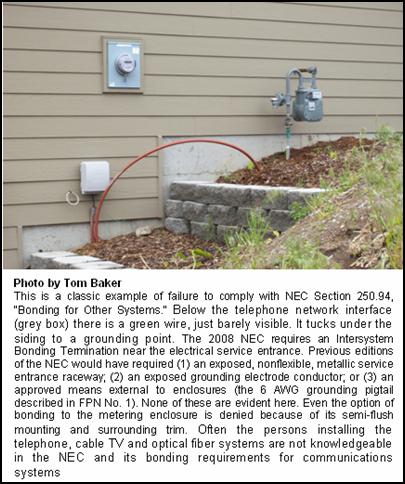NEC 250.94 – Bonding for Other Systems
 By Ed Lethert – The Low Voltage Guy
By Ed Lethert – The Low Voltage Guy
Bonding for Other Systems—as covered in Section 250.94 of the 2008 NEC—is a topic that requires serious attention by electricians, electrical contractors, electrical inspectors, electrical engineers, electrical designers, and technology workers. Compliance with this NEC rule is an essential part of any electrical installation, and the rule is applicable to ALL types of buildings and structures; residential, commercial, institutional, industrial, auxiliary, etc.). The increased use of sensitive electronic equipment in all types of structures, including residential dwellings, has made bonding and grounding a critical element of every electrical installation. This is certainly true of the communication services provided by telephone companies, cable companies, and antenna-based services. Note: The article uses the word 'bonding' since that is the operative term in 250.94. It is recognized that grounding is also accomplished.
The 2008 NEC Handbook states: "The Code requires that separate systems be bonded together to reduce the difference of potential between them due to lightning or accidental contact with power lines. Lightning protection systems, communications, radio and TV, and CATV systems must be bonded together to minimize the potential differences between the systems. Lack of interconnection can result in a severe shock and fire hazard."
Fine Print Note No. 2 of Section 250.94 identifies specific articles that are typical of "other systems (i.e. Articles 800, 810 and 820). ______________________________________________________________________________________________
FPN No. 2: See 800.100, 810.21, and 820.100 for bonding and grounding requirements for communications circuits, radio and television equipment, and CATV circuits
______________________________________________________________________________________________
The NEC does not limit other systems to just those articles identified in the fine print note. The rule also applies by reference to Article 770 and Article 830; and by inference to other systems such as those employed for security, fire, irrigation, etc. And it will undoubtedly apply to the new Article 840 that is to be included in Chapter 8 of the forthcoming 2011 NEC.
The 'bonding for other systems' rule has been in the NEC for a number of years. The rule remained relatively unchanged during that period of time. It was moved around some, being located in Section 250-71(b) of the 1993 Code and in Section 250-92(b) of the 1999 Code before finding what appears to be its dedicated and permanent home in Section 250.94.
The Code has, throughout that period, required that a facility must have at least one of the following means to provide for bonding of other systems.
(1) A non-flexible metal raceway, or
(2) An accessible grounding conductor, or
(3) An "other means" (such as a properly bonded and grounded 6 AWG pigtail – see 250.94, FPN No. 1).
The bonding conductor(s) for other systems could then be connected to one of these points using listed devices or fittings identified for the purpose, installed in accordance with included instructions per 110.3(B), and installed in compliance with 250.70.
ENTER THE INTERSYSTEM BONDING TERMINATION
250.94 has been substantially revised in the 2008 NEC, thereby affecting all of the aforementioned articles. As part of this revision, the NEC has identified a new device called the "Intersystem Bonding Termination" or IBT. The definition of the IBT can be found in Article 100 of the 2008 NEC.
____________________________________________________________________________________________________________________________________________________
Intersystem Bonding Termination. A device that provides a means for connecting communications system(s) grounding conductor(s) and bonding conductor(s) at the service equipment or at the disconnecting means for buildings or structures supplied by a feeder or branch circuit
____________________________________________________________________________________________________________________________________________________
The IBT provides a single, easily identifiable, physical terminal point to which all other systems are to be bonded. No additional hardware is required. Connect the bonding conductor to the IBT terminal … DONE! The IBT will eventually reduce significantly the number of hardware and connection point violations committed by 'other system' installers.
The 250.94 requirements are provided here in outline form to aid understanding. (For the official language and format see the 2008 NEC, 250.94 Bonding for Other Systems, Part V. Bonding).
First, 250.94 states the requirement for an intersystem bonding termination, that it must be accessible, and where it's to be located.
An intersystem bonding termination [IBT] for connecting intersystem bonding and grounding conductors required for other systems shall be provided
- external to enclosures [the IBT cannot be installed inside of an electrical enclosure that would be off-limits to technology workers, but it can be in its own enclosure, preferably nonmetallic]
- at the service equipment [the IBT is to be located as close to the service equipment as practicable; preferably on the outside of one- and two-family dwellings; usually inside for most other structures]
- or metering equipment enclosure [underlined portion to be included in the 2011 NEC]
- and at the disconnecting means for any additional buildings or structures. [an IBT is also required at any additional building or buildings on the premises that are served by feeders or branch circuits, and should be located as close as practicable to the disconnecting means of those buildings or structures]
Next, 250.94 addresses termination accessibility, capacity, and a concern for physical interference with electrical enclosures.
The intersystem bonding termination shall …
- be accessible for connection and inspection [it cannot be hidden or located in a place that is not readily accessible to installers and inspectors … Readily Accessible means "capable of being reached quickly for operation, renewal, or inspections without requiring those to whom ready access is requisite to climb over or remove obstacles or to resort to portable ladders, and so forth."]
- have the capacity for connection of not less than three intersystem bonding conductors. [the IBT is typically a bonding bar having a minimum of three connection points for communication system bonding and grounding conductors and a connection point for a minimum 6 AWG grounding conductor]
- not interfere with opening a service or metering equipment enclosure. [a common violation is found where a device used to facilitate communication system bonding is improperly attached to a meter socket enclosure and interferes with removal of the enclosure cover]
Finally, 250.94 specifies acceptable methods for establishing the intersystem bonding termination.
The intersystem bonding termination shall be one of the following:
(1) A set of terminals securely mounted and electrically connected to the meter enclosure or service equipment enclosure. The terminals shall be listed as grounding and bonding equipment. [underlined portions will be included in the 2011 NEC]
(2) A bonding bar near the service equipment enclosure, meter enclosure, or raceway for service conductors. The bonding bar shall be connected with a minimum 6 AWG copper conductor to an equipment grounding conductor(s) in the service equipment enclosure, meter enclosure, or exposed nonflexible metallic raceway.
(3) A bonding bar near the grounding electrode conductor. The bonding bar shall be connected to the grounding electrode conductor with a minimum 6 AWG copper conductor.
The language from previous editions of the Code is now the exception in the 2008 NEC and still applies for identification purposes where installations were made prior to implementation of the 2008 NEC. The exception is not included here because any new installation, and any alteration or repair of an existing installation, is required to comply with the current (2008) NEC. While this new requirement does not apply to existing installations that remain unaltered, most structures, dwellings in particular, can be upgraded to comply with the current rule without great difficulty or expense.
A reminder for those installing the intersystem bonding termination … Where a bonding conductor is part of the IBT installation, it should be kept as short and as straight as possible. This is essential to proper performance of any bonding and grounding system. NEC 250.4 has a Fine Print Note that states:
______________________________________________________________________________________________________________________________________________________
FPN: An important consideration for limiting the imposed voltage is the routing of bonding and grounding conductors so that they are not any longer than necessary to complete the connection without disturbing the permanent parts of the installation and so that unnecessary bends and loops are avoided
______________________________________________________________________________________________________________________________________________________
There are a number of changes in the electrical industry that mandate more careful attention to this rule by all concerned. These changes have affected all buildings and structures, and especially residential structures.
- The transition from metal raceway to PVC raceway at the service entrance.
- The "disappearance" of the accessible grounding electrode conductor on newer homes. This bonding point may have well have been one of the most popular, and most utilized, bonding points by telephone companies for many decades.
- The meter socket enclosure is located at the transformer rather than on or at the dwelling. This is particularly common in rural areas. Metal meter socket enclosures have been the one available and Code-permissible bonding point on many newer dwellings. Bonding to a meter socket enclosure probably comes in second to the grounding electrode conductor as a communication system bonding point.
The 2008 NEC Handbook bears out these facts when stating: "With the proliferation of plastic water pipe and the increasing tendency for service equipment (often flush-mounted) to be installed in finished areas, where the grounding electrode conductor is often concealed, as well as the increase of plastic service-entrance conduit, communications and CATV installers no longer have access to a point for connecting bonding jumpers of grounding conductors." This statement also applies to installers of antenna-based communication and entertainment systems.
The lack of a suitable bonding point on newer structures (dwellings in particular), and certainly poor training and supervision by some 'other system' service providers, has resulted in large numbers of communication system bonding violations. The Minnesota Department of Labor and Industry has more than amply documented this fact. At last, 'other system' installers have a designated location and device to which they are to connect their bonding conductors. This should, as the IBT becomes more common, dramatically reduce the number of bonding and grounding violations.
The Minnesota Department of Labor & Industry, Construction Codes and Licensing Division, sent an e-mail message to all Minnesota electrical inspectors back in November of 2006. It stated in part, "Please be certain that an accessible means for connecting intersystem bonding is provided at the service equipment for communication systems, radio and television equipment, CATV, and rod and dish-type antenna systems. Refer to the requirements and fine print notes at NEC 250.94 … ." The requirements in 250.94 have been altered since this message was sent, but the imperative has not changed.
Intersystem Bonding Termination products are available from a number of sources to facilitate compliance with Section 250.94. These sources include Arlington Industries, Burndy, Electric Motion Company, Erico, Greaves, Harger, Ilsco, Thomas and Betts, and others. Local electrical distributors stock these products.
 A two-page handout document similar to this article is available as a PDF and can be found on the author's web site at www.mnpowerlimited.com. The author encourages copying and distribution of that document to all interested parties, particularly electricians and electrical contractors.
A two-page handout document similar to this article is available as a PDF and can be found on the author's web site at www.mnpowerlimited.com. The author encourages copying and distribution of that document to all interested parties, particularly electricians and electrical contractors.
Ed Lethert — The Low Voltage Guy
Ed Lethert Associates, Inc.
Minneapolis, MN 763-545-0030
www.mnpowerlimited.com or www.lowvoltageguy.com
Email: Ed@mnpowerlimited.com